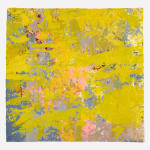-
Sam Gilliam
Untitled (It's Yellow), 1973Gouache, watercolor, and screenprint on handmade paper20 7/8 x 20 7/8 in (53 x 53 cm)© 2025 Sam Gilliam / Artists Rights Society (ARS), New York. Courtesy of Zeit Contemporary Art, New YorkPOAFurther images
In the early 1970s, Sam Gilliam's works on paper, particularly his gouaches and watercolors, became a vital aspect of his oeuvre and a notable contribution to post-war American art. These...In the early 1970s, Sam Gilliam's works on paper, particularly his gouaches and watercolors, became a vital aspect of his oeuvre and a notable contribution to post-war American art. These works signify a period when Gilliam, already celebrated for his draped canvases, began to explore the fluidity and translucency of water-based media. This phase was not simply an aesthetic exploration but was profoundly intertwined with the socio-political context of the time. As the Civil Rights Movement catalyzed a national reckoning on race and equality, Gilliam’s abstract works engaged in a visual discourse on freedom and fluidity, metaphors for the aspirations of African American communities. The unrestricted flows of pigment and the spontaneous intermingling of colors on paper could be read as allegories for the desired dissolution of rigid social segregations and the celebration of individual identity. By pushing the formal possibilities of abstraction, Gilliam's art could be seen as an assertion of autonomy and a form of resistance to the conventional constraints of both society and traditional art forms.Gilliam's experimentations were radical; they contributed significantly to the diversification of the American art scene by demonstrating that abstraction could carry cultural and political resonance. His works from this period reflect an unbounded enthusiasm for the potential of color as a communicative tool. The depth and richness of his palette transcended mere aesthetics, speaking to a sensory and emotional experience that paralleled the era’s quest for racial and social justice. His abstract language became a visual counterpart to the Civil Rights Movement, as it sought to transcend the limitations of narrative art, offering instead a universal form that could evoke a collective human experience, beyond the specifics of race or creed. In this way, Gilliam's art became a space for contemplation and solidarity, reflective of a society in transition.
The present work completed in 1973 stands as a testament to Gilliam's mastery of his medium and his ability to infuse his work with layered meanings. The dominance of yellow—a color often associated with warmth, energy, and visibility—commands immediate attention and radiates an optimistic vitality. Yet, the complexity of the artwork is revealed through Gilliam’s nuanced use of hue and texture, where the interplay of muted blues, pinks, and hints of raw paper under the yellow suggests depth and dimension. The piece evokes an emotional response akin to the introspection and aspiration for a brighter future that characterized the era it was born in. ‘It’s Yellow’ thus becomes more than an object of visual intrigue; it embodies the spirit of its time, showcasing the power of abstract art to encapsulate and contribute to the cultural and social shifts of its day.
NOTES
This artwork is signed and dated in pencil ‘Sam Gilliam 73’ on the lower right side. It is also inscribed in pencil on the verso ‘It’s Yellow.’ This work is unique.
We extend our gratitude to Ms. Annie Gawlak, President of the Sam Gilliam Foundation, for her invaluable assistance in cataloguing this work.
Provenance
Private collection, Wisconsin
Private collection, United States
Private collection, New York






